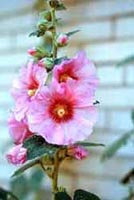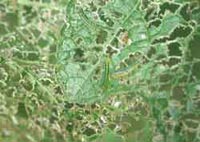Resource Library
Plant of the Week: Hollyhock
The University of Arkansas System Division of Agriculture does not promote, support or recommend plants featured in "Plant of the Week." Please consult your local Extension office for plants suitable for your region.
Plant of the Week
Hollyhock
Latin: Alcea rosea

I tell students learning to identify plants to remember that hollyhock is the one with all the holes in the leaves. Bugs just love it, yet the plant is tough enough to strike up a ragged coexistence that permits it to thrive even though its leaves look like Swiss cheese.
Hollyhock (Alcea rosea) is a member of the hibiscus family, the same family to which cotton and okra belong. It is an old fashioned biennial or short lived perennial that can grow to 6 feet tall. Plants have a decidedly tall, upright form with the blooms produced along terminal portion of the main stem.
Red is the most common color for hollyhock but breeders have made selections in shades of pink, purple, yellow, white and even black. The flowers, produced from large prominent buds, are borne singly up the stem with each bloom remaining open 3 or 4 days during late spring and early summer. As the four-week long blooming season progresses, the bloom front advances towards the ends of the leafless stems.
Single-flowered hollyhock blooms are to 3 inches across and have the typical protruding stamenal column found in the hibiscus family. Double forms are available which look like powder puffs. The flowers are highly fertile and produce large quantities of seed in round, flattened capsules.
Hollyhock is an Asian native that was introduced to the West during the early days of Chinese trade, probably about the beginning of the Christian era. The Crusaders brought the single flowered form back to England during the middle ages. The Anglo-Saxon name for mallow, a closely related species used medicinally throughout Europe, was "hoc", thus hollyhock was the "holy hoc" from Jerusalem.
During the 19th century, hollyhock became a favorite of Victorian gardens as new colors and the double flowered forms were introduced from China. It is still a mainstay for cottage gardens and perennial borders where its height and dependability is needed.

Hollyhock is not for the fastidious gardener who agonizes over every calamity that may befall a plant. This old timer seems to live under its own cloud, for some affliction is always waiting in the wings to attack it. Of these, the hollyhock sawfly is probably the most common in Arkansas.
The larval form of the hollyhock sawfly (also called the hibiscus sawfly) is a leaf skeletonizer that munches its way through the foliage leaving behind see-through leaves consisting of patches of leaf tissue and the main leaf veins. The translucent green worms are up to ½-inch long and kind of club shaped with a black spot on their head and on spines located on each body segment. They seem to get lonely for it is not uncommon to see them grazing side by side like a heard of cattle in a lush pasture.
As the larval form matures it spins a dirty silken web over itself, usually near the base of the plant, and pupates. The adult insect is a black fly with an orange thorax that is about 1/3-inch long. The insects have split antennae that are divided almost to the base, making them look like they have four instead of the customary pair. The adults lay their eggs singly in the leaf tissue and can have as many as six generations per year in the South.
Control is not especially difficult but should be initiated as soon as the first holes are seen on the lower leaves. Sevin or BT should prove effective. I have not controlled the hollyhock sawfly on the plants in the campus garden and have seen no sign of natural enemies attacking the pest. I did observe the adult sawfly attack the caterpillar of a competing species, thus assuring more room for its own brood.
Even though hollyhocks are plagued by several problems, they are not difficult to grow. They grow best in sunny sites with a reasonably fertile soil. Container grown plants that are started in the winter will flower the first season. Seed sown in midsummer out of doors will produce flowering plants the following spring. Individual plants may only persist a few years, but reseeding will keep the plants in the garden.
By: Gerald Klingaman, retired
Extension Horticulturist - Ornamentals
Extension News - July 5, 2002
The University of Arkansas System Division of Agriculture does not maintain lists of retail outlets where these plants can be purchased. Please check your local nursery or other retail outlets to ask about the availability of these plants for your growing area.